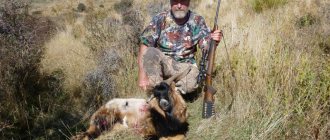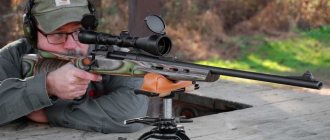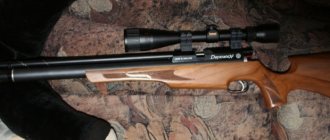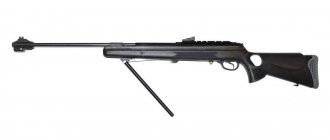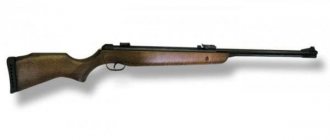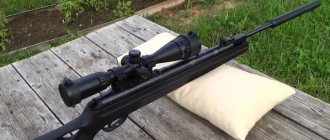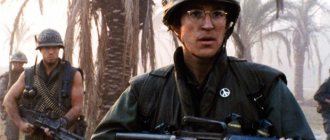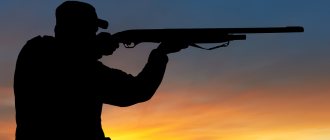Power – depends on the target being hit
A bullet flying from a rifle has a certain weight and speed, which are converted into impact energy. Ideally, this bullet pierces the animal’s carcass and then remains inside. If it goes right through, it means that the power is too high.
The following calculations are accepted: 10 joules of power are required per kilogram of production. In Russia it is allowed to use rifles for hunting up to 25 joules.
It can be noted that pneumatic type weapons with power:
- Not reaching 3 joules is just a misunderstanding;
- From 3 to 7.5 joules - can only serve as a toy;
- From 7.5 to 16 joules - considered sports, sold freely;
- From 16 to 25 joules - used for hunting, a permit is required.
Some manufacturers use a little trick - they weaken weapons with a power of 16 joules to 7.5 joules, but at the same time put the letter “F” in the pentagon. An understanding person can easily restore the original parameters (16 joules), and no one will require permission when purchasing. So, if desired, a craftsman can buy himself a low-power rifle, and then increase its power to the required one. But not every rifle is suitable for this, and not everyone can handle it.
Features of hunting
Weapons legislation of the Russian Federation
The circulation and use of weapons is based on the Federal Law of the Russian Federation “On Weapons” No. 150 FZ (hereinafter referred to as the Law), which came into force on December 13, 1996.
In accordance with the law, pneumatics are weapons that use the force of compressed gas to remotely hit a target.
All weapons available to citizens of the Russian Federation can be divided into two groups:
- civil;
- hunting
The energy that a bullet can carry when leaving a barrel is limited by law
- for a pistol - 3...7.5 J;
- for a rifle – up to 25J;
At the same time, weapons whose power does not exceed 7.5 J are sold freely and do not require registration. If the shot energy exceeds 7.5 J, then registration and licensing are required.
It should be noted that in order to fit within the framework of the Law, manufacturers deliberately weaken their products to 7.5 J, but the kit, as a rule, includes either a powerful spring in the case of PPP, or a re-bleed[1] of normal diameter for PCP in order to return design power. Of course, by returning power to the rifle in excess of 7.5 J, the owner is breaking the law and acting at his own peril and risk.
There are clear restrictions on the use of weapons powered by compressed air; the following actions are prohibited:
- use in public places, as well as places not specifically intended for this purpose (outside shooting ranges and shooting ranges);
- point the barrel at a person or other living creature, since the bullet has sufficient energy to cause significant harm to health;
- shooting within the city.
Pneumatics with a power of up to 7.5 J are not suitable for hunting, since the energy imparted to the bullet is too little to harm the object of the hunt. For example, a duck will only be injured, and with a high degree of probability will die, somewhere wounded in agony. Which has nothing to do with the goals and objectives of hunting.
Accordingly, you should obtain a license to purchase powerful pneumatics with energy from 7.5 to 25 J, preferably with a caliber higher than 4.5 mm. In addition, legal hunting requires a ticket and a permit to enter the farm.
The list of fauna objects permitted with pneumatic weapons is contained in the Hunting Rules, namely:
- squirrel,
- chipmunk,
- flying squirrel,
- turtledove,
- grouse,
- crow.
Thus, the hunting of other animals using pneumatics is not permitted, however, it is carried out privately with the permission of the huntsman, or in private hunting grounds.
How to buy a rifle
Article 10 of the Law states that an adult citizen of the Russian Federation has the right to own and trade civilian weapons. After purchase, licensed pneumatic weapons must be registered with the police department at your place of residence. The police department issues a permit to carry weapons for 5 years.
If a citizen wishes to purchase a sporting weapon with a power of over 7.5 J, he must submit documents confirming that he is involved in shooting sports. To purchase weapons whose power does not exceed 7.5 J, a license is not required, nor is registration with the Department of Internal Affairs.
For illegal storage, use and circulation of the Code of Administrative Offenses of the Russian Federation, administrative liability is provided for citizens.
Separation of pneumatics according to operating principle
The following groups can be distinguished:
- spring-piston or PPP;
- using compressed air or PCP;
The first is cheaper, easier to operate and does not require additional equipment. All you have to do is buy a rifle and pick up some bullets and you can go shoot.
The downside of the PPP is the recoil. In addition, the vector of impact as a result of a shot from a firearm is directed backwards; optical sights are designed for this from the outset. The recoil vector of the PPP is directed forward, so durable optical sights are required, because some of them quickly fail when used on powerful rifles.
PCP is a powerful and accurate weapon. To fire a shot, compressed gas is used, pumped in advance into a tank, usually placed under the barrel using a pump or high-pressure cylinder. PCP rifles are much more expensive and more difficult to operate; in addition, you should immediately purchase either a pump, which ensures mobility, or then you need to look for a place where you can subsequently refuel it.
You can point out another advantage of the PCP - rifles and pistols are produced not only in caliber 4.5 mm, which is typical for PPP, but also in calibers such as 5.5, 6.35, 9, 12 mm, which expands the range of objects for hunting, and guarantees reliable defeat of game.
Caliber – from “children’s” to “grandfather’s”
- “Children’s” caliber is called 4.5 mm - it is suitable for hunting game weighing from 0.2 to 1.5 kg. In other words, with such a rifle you can shoot both a duck and a blackbird if you hit the body. When shot in the head, you can hit larger prey - from 1.5 to 5 kg. This is, for example, a hare, pheasant or black grouse. You can shoot from a distance of up to 60 m.
- “papal” among hunters - it is suitable for shooting at the body of a hare, pheasant or smaller bird (game weight - from 0.5 to 4 kg, distance - up to 30 m). By shooting in the head you can kill a fox, beaver or marmot (distance - up to 70 m).
- The “grandfather’s” caliber is quite capable of hitting the body of both ducks and pigeons and hares and foxes. A powerful 6.35 mm rifle combined with a well-aimed head shot will hit not only a beaver and a marmot, but also a roe deer.
- The powerful 9 mm caliber doesn’t even have a special name – you can use it to hunt almost any animal (especially when using heavy lethal bullets). Roe deer, fox, hare, black grouse, pheasant, even wild boar, will be killed on the spot. Just don’t shoot pigeons with such a caliber - big holes will remain. However, such a rifle is quite heavy (it weighs up to 4 kg), and it also has high recoil and a supply of only 15 bullets. The bullets themselves are rarely found on sale, so homemade ones are often purchased for hunting.
In the video we select the caliber of bullets for hunting:
Hunting with pneumatics
Photo Eric/flickr.com
I shot an air rifle as a child. My brother and I had a German, so to speak, trophy, Mauser air rifle. It was very rare then; the mainspring was cocked using a lever in the form of a rifle bolt handle.
They shot mainly at targets with 00 (4.5 mm) shot, which was stuffed into the magazine. The rifle was powerful and heavy and fired loudly; From time to time, crows would strike from the window, up to 20 meters away. In the yard, the crows wouldn’t let us with a rifle get to such a close distance; they would fly away. This is where my acquaintance with pneumatics ended. Having been hunting since I was 14 years old, for a long time I had no idea that air rifles would take their rightful place in a hunter’s arsenal.
About 12 years ago I first saw hunting air rifles of various calibers in the UMAREX-Moscow gun store, but I didn’t take them seriously as a hunting weapon, perhaps because of the rather high price. These were English air rifles with a reservoir for compressed air of the PCP system (from the English Pre Charged Pnevmatic), that is, pneumatics with pre-pumping of air under high pressure.
By the way, from history. Air rifles with reservoirs appeared in Europe more than three centuries ago; air was pumped into the reservoir by a special high-pressure pump up to 70 atmospheres. They fired bullets with a diameter of about 15 mm from such rifles at a distance of up to 70 meters. The tanks, as a rule, were replaceable; depending on the tank, there was enough air for 5–20 or more shots.
In those days, their advantage was obvious: when fired, no smoky powder clouds were formed, the problems were in pumping the tanks. Only very rich people could purchase such hunting rifles because of their high cost. The Stockholm Museum houses a similar hunting air rifle from the 12th century, which belonged to Queen Christina Augusta.
Having recently had the opportunity to thoroughly familiarize myself and study the hunting air rifles of the PCP system, I have identified a number of their advantages over hunting firearms for some types of hunting.
First of all, they are distinguished by very high shot accuracy, and therefore only optical sights are used for them. If a shot from a smoothbore shotgun from a 70 mm cartridge is effective at a distance of up to 50 m, then from an air rifle you can shoot at a distance of up to 100–120 meters. When shooting from such a rifle with a caliber of even 9 mm, the recoil of the shot is practically not felt.
Hunting air rifles themselves, especially those with a caliber of more than 6.35 mm, shoot loudly, almost like rifled rifles, but in a hunting air rifle it is allowed to use a moderator, that is, an ordinary muffler, and when firing only the sound of the trigger is heard. The use of such a device on firearms is prohibited by law - it is classified as poaching.
The entire structure of the PCP air rifle revolves around the reservoir. Most often it is placed under the rifle barrel in the form of a pipe with a diameter of 20–30 mm and a capacity of 200–500 cubic meters. cm. A plug with an inlet valve for pumping air is screwed into the front of the tank; the other side of the tank is screwed into the high-pressure chamber of the rifle receiver.
This chamber contains a combat valve with a rod and spring. A barrel is attached to the top of the reservoir in the receiver, which is connected to the high-pressure chamber by a bypass hole. The trigger and firing pin with mainspring are located in the receiver behind the high-pressure chamber. At the top of the box in front of the barrel there is space for a magazine with bullets.
Next, a bolt with a bullet rammer from the magazine into the barrel is placed. The bolt, with its protrusion, engages with the firing pin and, when moving back, puts the firing pin into combat cocking. Most PCP rifles have pressure gauges installed to monitor tank pressure. In some cases, the reservoir is attached to the receiver at the back and, with the butt plate attached, acts as a butt.
To increase the number of shots and power, some rifle models are equipped with two reservoirs - one in front under the barrel, the other in the back in the form of a butt.
Air is supplied to the tank or, speaking in the language of the pros, it is filled through the inlet valve using a charger from a high-pressure cylinder of 300 atmospheres; 5- and 7-liter scuba tanks are most often used. The tank is “filled” with air to a pressure of 200 atmospheres.
You can pump up the tank, like 300 years ago, with a high-pressure pump, but, frankly speaking, this can only be done by a physically developed shooter weighing at least 90 kg.
When you press the trigger of the trigger of the rifle, the firing pin disengages from the sear, under the action of the mainspring, the firing pin hits the firing valve rod, and a portion of high-pressure air enters the barrel through the bypass hole - a shot occurs. Then, under the action of the spring and air pressure in the reservoir, the valve returns to its place - the seat blocks the access of air to the barrel.
With each shot, the air pressure in the rifle's reservoir drops, and the force of its influence on the firing valve decreases, while the force of the firing pin's mainspring remains constant. Thus, after each shot, the closing moment of the valve increases, and more air breaks into the bypass hole of the barrel. There is an effect of self-regulation of air pressure in the barrel, which makes it possible to fire several dozen shots with a stable initial bullet speed.
You can check this using a special device - a chronograph. As a rule, the stability of the bullet’s flight speed is maintained at a pressure in the tank from 200 to 120 atmospheres. Within these limits, a balance is created between the impact of the firing pin mainspring on the forces of the main valve spring and the air pressure on it from the reservoir.
To increase the number of stable shots from the first to the last, some RCP rifles are equipped with two-chamber gearboxes, which require careful debugging for a bullet of the same weight, and this is a piece production.
The development of a modern hunting air rifle of the PCP system began in the second half of the last century in England, started by the English company Daystate, and to this day England occupies a leading place in the development and production of these rifles. Such rifles are produced in Turkey, Sweden, South Korea and China, but the best examples remain English.
The most common calibers in hunting airguns are 5.5 mm, 6.35 mm and 9 mm; RCP and 7.62mm rifles have recently started arriving. Using a 5.5 mm rifle with a bullet weight of 1–1.2 grams, the shot is effective up to 100 meters, and you can hit a bird weighing up to 400 grams - it all depends on the accuracy of the shooter and the quality of the optical sight. As a rule, these rifles use optical sights of at least 10x.
With a 6.35 mm rifle, you can hunt hare, fox and wood grouse at the same distance, and this rifle’s power is already close to that of a small-caliber long-barreled firearm. With a 9 mm caliber it is already possible to kill an animal up to 80 kg. For a well-aimed shot at such a distance, it is important to choose a good ammunition - a bullet. There are many bullets of different calibers on sale, you just need to know how to choose the right one. Here it is already necessary to consult a consultant.
I am deliberately keeping silent about the power of the RSR hunting air rifle, because the Federal Law “On Weapons” limits their power to 25 J. Such rifles are purchased under a license, like smooth-bore weapons, and are subject to registration with the police. Naturally, the power of such rifles is higher. For example, the power when fired from a 6.35 mm rifle at a distance of 100 meters should be 100 J.
You can only hunt with an air rifle of a hunting type. According to the Hunting Rules, approved by order of the Ministry of Natural Resources of the Russian Federation dated April 10, 2012, only “... the use of pneumatic hunting weapons is possible, with the exception of hunting flying squirrels, doves, hazel grouse, crows, if the latter are classified as hunting resources by the laws of the constituent entities of the Russian Federation... “And only, other cases are considered as poaching.
Let us remind you that, according to paragraph 3.2 of these Rules, when hunting, the hunter must have with him a hunting license of a single federal standard, a permit for the right to store and carry a hunting pneumatic weapon, and a permit for the extraction of a specific hunting resource, obtained in the prescribed manner.
Yaroslav Tychkin June 2, 2014 at 00:00
Choosing the type of pneumatic system for hunting
Spring-piston type (PPP)
The bullet is driven by a piston with a spring, which, with a caliber of 4.5 mm, gives the bullet an acceleration of 300 meters per second. Rifles of this type are mainly limited to this caliber, since such speed is clearly insufficient for larger-caliber weapons. By replacing the spring, the power can be increased, but even then the bullet will not fly faster than 320 meters per second.
Hunters call a rifle with such a system a “paddle”; it is quite bulky and large, suitable only for small game, and it is unlikely to help you catch black grouse. And you need to wait at least 5 seconds between shots.
And after every 7 thousand shots the spring has to be changed - in some models even earlier. But these models are the cheapest, and they are also convenient due to their autonomy (they do not need to be pumped up). You can walk through the forest, hunting for your own pleasure.
Pre-pumped (PCP)
This type of rifle is the best for hunting. It has a reservoir with air compressed under high pressure. One blowing (pumping) of this cylinder is enough for a series of shots from 20 to 100. The mechanism can be single-shot or multi-shot (with a drum from 6 to 14 bullets), as well as direct-flow (with a pressure of 200 bar) and gearbox (with a pressure of 300 bar). This type of rifle is produced in all known calibers - from “children’s” to nine-millimeter, so you can hunt any animal and bird with it. Their main disadvantage is their high cost.
Detailed instructions describing the installation procedure, how to zero the optical sight and its subsequent maintenance. You can also learn about focusing, parallax adjustment, and installing an anti-reflective lens hood here. How to make an air rifle with your own hands? Read manufacturing secrets, drawings and diagrams.
Multi-compressor type
There is a reservoir under the barrel into which air is pumped and then the shot is fired. The speed of the bullet is low (up to 250 meters per second). Therefore, here too the caliber is limited to 4.5 mm. The second shot has to be fired after 30 seconds, not earlier (due to the loading time). This rifle is only suitable for not very large game, but it is autonomous, compact and quiet.
CO2 pneumatics
These rifles are also called carbon dioxide (or gas-cylinder) rifles. Here, the energy to accelerate the bullet is provided by a can of carbon dioxide under a pressure of 50 to 70 bar. From such a weapon you can fire a series of shots, and automatically.
However, when hunting with such a rifle, difficulties may arise due to the dependence of CO2 on low temperatures.
The game probably won’t want to wait until you warm up the spray can. Moreover, the speed of the bullet is not very high - about 250 meters per second. Therefore, in its “pure” form, such weapons are not very suitable for hunting.
However, such rifles are much cheaper than PSPs, so some hunters decide to reconstruct them. They pump ordinary air instead of CO2, and in some cases they simply replace the cylinder with an air tank. There are other options for modification, but for this you need to have special knowledge.
Russian pneumatics PCP Ataman M2R Tactic Type-2
PCP Ataman M2R Tactician Type-2
The Russian-made PCP Ataman M2R Tactic Type-2 air rifle is a 5.5 mm PCP rifle that can be stored and used without a license.
The mechanism of operation of such a device is based on the basic principles of a longitudinally sliding rotary bolt, which is locked by the barrel bore using lugs.
The Ataman air rifle has a fairly voluminous “match” barrel, which is made from high-quality cold steel, equipped with a powerful muzzle brake compensator and an equally powerful muffler, which suppresses the sounds of the Ataman rifle’s firing as much as possible.
Technical and constructive aspect:
| Model of the presented weapon | PCP Ataman M2R Tactician Type-2. |
| Calibration of ammunition used during shooting | 5.5 mm spherical bullets. |
| Rifle ammunition type | single shot. |
| The maximum initial firing velocity of the cartridge is | 280 km/s. |
| The greatest effective firing range of a cartridge corresponds to | 100 m. |
| Overall length of the model | 1.12 m. |
| Barrel and butt length | 55 and 55.2 cm respectively. |
| The weight of the weapon does not exceed | 3.3 kg. |
| Starting price of the model | from 71,000 rubles. |
Advantages:
- the presented model of the rifle has established itself in the world arena of air guns as a high-quality and very reliable model;
- The quality of such a device literally has no equal;
- excellent shot accuracy;
- high firing speed of cartridges;
- Thanks to a special mechanism, the sounds of cartridges firing can be perceived as shooting from a conventional small-caliber weapon.
Flaws:
- small effective firing range;
- very high price - from 71,000 rubles.
Hatsan hunting rifle
One of the largest arms manufacturers is the Turkish company Hatsan Arms Company. Its air rifles are distinguished by high quality and excellent performance combined with a not very high price.
Pneumatics are of the spring-piston type, but the developers were able to achieve a high bullet speed of 380 meters per second. These data refer to the popular Hatsan 125 rifle - 2006 model. Since then, the number of its sales has only been gaining momentum.
Experienced hunters claim that with this magnum class rifle you can “get” a bird from 75, and sometimes even from 150 m. A comfortable stock, an adjustable sight and space for an optical sight, low weight and high bullet lethality guarantee a successful hunt. Here are its characteristics:
- Rifle caliber – 4.5 mm;
- Bullet flight speed (initial) – 380 meters per second;
- Rifle length – 1.255 m;
- Weight – 3.6 kg;
- Barrel length – 0.51 m;
- Safety type – automatic trigger.
Choice
As a rule, airgun manufacturers produce guns in the PCP format (using “pre-pumping”).
The principle of operation is to release a certain amount of substance from a special gas reservoir, which creates the power required for the shot.
Break-type rifles are not recommended for experienced hunters, as they have a reduced rate of fire and unreliable design.
Expert advice: when choosing a pneumatic weapon, first of all you should pay attention to such a characteristic as the initial velocity of the bullet. The optimal option is one where this indicator is at least 150 m/s.
Which pneumatics without a license are suitable for hunting, examples of rifles
Pneumatic weapons are increasingly being used as hunting weapons. The popularity of pneumatics is due to its undeniable advantages:
- relatively small weight;
- no need to obtain a license;
- low noise level;
- low cost.
But the legislative aspects of hunting should be considered separately, since in theory and practice there are so many disagreements that the topic of hunting with an air rifle without a license is perhaps the most discussed in interested circles. And if you can choose a pneumatic to hunt legally, then what parameters should you pay attention to?
Features of hunting with air guns
First of all, it should be noted that hunting with pneumatics has a number of beneficial advantages that directly arise from the qualities of this type of weapon.
- The shot of a firearm is so loud that it can sometimes be heard for several kilometers, and this can scare away the animal.
- When hunting for small game, it is convenient to carry a pneumatic gun due to its light weight.
- Servicing an air gun involves its partial disassembly and cleaning, but this is done much less frequently than when servicing firearms.
- Despite the impact force, which in some models reaches high values, pneumatics are considered safer.
- Relatively low costs for purchasing the weapon itself, as well as ammunition.
It is traditionally believed that targeted shooting from a pneumatic weapon is possible only at a distance of up to one hundred meters, since the energy of the shot is far from the energy of a real hunting rifle. But some samples of heavy-duty pneumatics are even suitable for hunting large animals.
Finally, the most attractive thing about air rifle hunting is the fact that many types of weapons can be used without a license or permit. However, the very concept of hunting and pneumatic weapons somehow do not get along in the law. It is necessary to further understand the nuances of Russian legislation. Otherwise, confusion can bring a law-abiding citizen under the criminal law.
We encounter the first paradox in terms. First, the law on weapons tells us that hunting with pneumatic guns is prohibited in Russia. Between the lines we read the principle of humanity, because often an animal wounded by a pneumatic bullet is doomed to a painful death.

